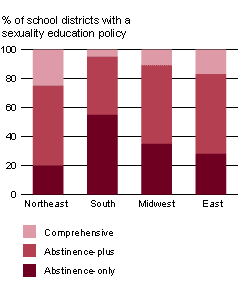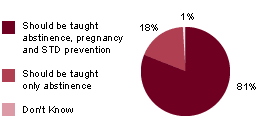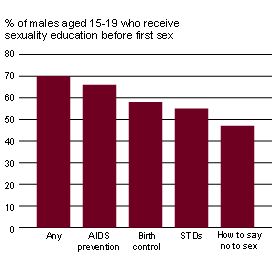Sex Education: Politicians, Parents, Teachers and Teens
For two decades, policymakers have debated the relative merits of sexuality education that promotes abstinence as the only acceptable form of behavior outside of marriage and more comprehensive approaches that discuss contraception as well. The results of several new studies show that these debates may have had a considerable impact on what is being taught in the classroom; moreover, they strongly indicate that politicians—in their drive to promote morality-based abstinence-only education—are out of touch with what teachers, parents and teens think should be taught.
In 1981 Congress passed, and President Reagan signed into law, the Adolescent Family Life Act (AFLA). Through AFLA, the federal government for the first time invested on a small scale in local programs designed to prevent teenage pregnancy by encouraging "chastity and self-discipline" among teenagers. AFLA helped usher in 20 years of debate at the federal, state and local level over whether sexuality education should exclusively promote abstinence or should take a more comprehensive approach.
In the late 1990s, federal investment in this area increased significantly after Congress, as part of the 1996 welfare reform law, created a federal-state program funded at $440 million over five years to support local sexuality education programs that condemn all sex outside of marriage—for people of any age—and prohibit any positive discussion of contraception. Four years later, conservative lawmakers secured an additional victory when Congress approved a third abstinence-only education program funded at $50 million over two years through a set-aside in the maternal and child health block grant.
Yet this major increase in federal funding occurred despite evidence that shows that more comprehensive sexuality education, rather than abstinence-only education, helps teenagers to delay sexual activity. It also occurred without clear pictures of either local sexuality education policies or the content of classroom instruction. Several studies published within the past year fill in these gaps, highlighting a significant disparity between the inclinations of policymakers and the needs and desires of both students and parents (see box). This research also suggests that there is a large gap between what teachers believe should be taught regarding sexuality education and what is actually taught in the classroom.
Local Policy
More than two out of three public school districts have a policy mandating sexuality education, according to research published in 1999 by The Alan Guttmacher Institute (AGI). Most of these policies—more than eight in 10—were adopted during the 1990s, a period of intense debate in many state governments and local communities over whether sexuality education curricula should include information about contraception as well as the promotion of abstinence.
This AGI research, based on a nationwide survey of school superintendents, found that local policies overwhelmingly encourage abstinence. Eighty-six percent of school districts with a sexuality education policy require promotion of abstinence; 51% require that abstinence be taught as the preferred option but also permit discussion of contraception as an effective means of protecting against unintended pregnancy and sexually transmitted diseases (STDs); and 35% require abstinence to be taught as the only option for unmarried people, while either prohibiting the discussion of contraception altogether or limiting discussion to contraceptive failure rates. Only 14% have a truly comprehensive policy that teaches about both abstinence and contraception as part of a broader program designed to prepare adolescents to become sexually healthy adults.
The AGI study found significant regional variation in the prevalence of abstinence-only policies (see chart a). School districts in the South are most likely to have such policies (55%) and are least likely to have comprehensive programs (5%). In contrast, school districts in the Northeast are least likely to have an abstinence-only policy (20%).
| chart a Sex Ed Geography |
|---|
| The type of sexuality education policy adopted by school districts varies widely by region.. |
 |
|
Source: Landy DJ, Kaeser L and Richards CL, Abstinence promotion and the provision of information about contraception in public school district sexuality education policies, Family Planning Perspectives, 1999, 31(6):280-286. |
Clearly, state and local policymakers have strongly supported abstinence promotion for some time; the AGI study was conducted even before states began implementing abstinence-only programs funded under the 1996 welfare reform law. Districts that switched their policies during the 1990s were twice as likely to adopt a more abstinence-focused policy as to move in the other direction. Half of school superintendents surveyed cited state directives as the most important factor influencing their current policy; approximately four in 10 cited school boards or special committees.
Teachers
Not surprisingly, this shift in policy has had an impact on teachers and the content of sexuality education. A second AGI study, based on a survey of public school teachers, shows that since the late 1980s, sexuality education in secondary schools has become more focused on abstinence and less likely to provide students with information about contraception. The survey results, published in 2000, show that the percentage of public school teachers in grades 7-12 who teach abstinence as the only way of preventing pregnancies and STDs rose dramatically between 1988 and 1995—from one in 50 to one in four. Additionally, nearly three in four present abstinence as the preferred way to avoid unintended pregnancy and STDs.
Teachers are also emphasizing different topics than they did in the past. Compared with teachers in the late 1980s, teachers today are more likely to teach about abstinence, STDs and resisting peer pressure to have sex, but are significantly less likely to discuss more "controversial" subjects such as birth control, abortion and sexual orientation. And while some topics—such as HIV and other STDs, abstinence, correct condom use and resisting peer pressure—are taught earlier than they were in the past, most are still taught less often and later than teachers think they should be.
Although more than nine in 10 teachers believe that students should be taught about contraception (and half believe that contraception should be taught in grade seven or earlier), one in four are instructed not to teach the subject. And while the vast majority also believe that sexuality education courses should cover where to go for birth control, information about abortion, the correct way to use a condom, and sexual orientation, far fewer actually cover these topics (see chart b).
| chart b Thinking vs. Doing |
|---|
| There is a large gap between what teachers think should be taught and what they teach |
 |
| Source: Darroch JE, Landry DJ and Singh S, Changing emphasis in sexuality education in U.S. public secondary schools, 1988-1999, Family Planning Perspectives, 2000, 32(5):204-211 & 265. |
Even if teachers are allowed to cover these sensitive topics, they may avoid them because they fear adverse community reaction; more than one-third report such concerns. All in all, these pressures and limitations lead one in four teachers to believe that they are not meeting their students' needs for information. A similar percentage of fifth- and sixth-grade teachers who teach sexuality education believe that schools are not doing enough to prepare students for puberty or to deal with pressures and decisions regarding sexual activity. Finally, a study published last year by the Centers for Disease Control and Prevention found that a significant proportion of health educators in secondary schools want additional training in the areas of pregnancy, STD and HIV prevention.
Parents
Most parents (65%) believe that sex education should encourage young people to delay sexual activity but also prepare them to use birth control and practice safe sex once they do become sexually active, according to interviews conducted for the Kaiser Family Foundation in 2000. In fact, public opinion is overwhelmingly supportive of sexuality education that goes beyond abstinence (see chart c). Moreover, public opinion polls over the years have routinely showed that the vast majority of Ameri-cans favor broader sex education programs over those that teach only abstinence.
| chart c Public Opinion |
|---|
| Americans overwhelmingly favor broader sexuality education programs over those that discuss only abstinence.. |
 |
| Source: The Henry J. Kaiser Family Foundation/ABC Television, Sex in the 90s: 1998 National Survey of Americans on Sex and Sexual Health , Sept. 1998. |
Kaiser reports that among the one-third of parents who say that adolescents should be told "only to have sex when they are married," an overwhelming majority also say that schools should teach adolescents how to get tested for HIV/AIDS and other STDs (86%), how to talk to a partner about birth control and STDs (77%), how to use condoms (71%), and where to get and how to use other birth control methods (68%). This suggests that parents and policymakers differ in their understanding of what it means to present abstinence as the only option outside of marriage, and that policies that prohibit any discussion of contraception or that portray it as ineffective may not reflect the desires of most parents.
In addition to topics that are routinely covered in sexuality education classes—such as the basics of reproduction, HIV and STDs, and abstinence—parents want schools to cover topics often perceived to be controversial by school administrators and teachers. Kaiser found that at least three-quarters of parents say that sexuality education classes should cover how to use condoms and other forms of birth control, abortion, sexual orientation, pressures to have sex and the emotional consequences of having sex. Three in four parents believe that these topics should be "discussed in a way that provides a fair and balanced presentation of the facts and different views in society." Yet most of these topics tend to be the very ones that teachers shy away from or are prohibited from teaching. Finally, most parents believe that the amount of time being spent on sexuality education should be significantly expanded.
Students
According to Kaiser, students report that they want more information about sexual and reproductive health issues than they are receiving in school. Approximately half of students in grades 7-12 report needing more information about what to do in the event of rape or sexual assault, how to get tested for HIV and other STDs, factual information on HIV/AIDS and other STDs, and how to talk with a partner about birth control and STDs. Two in five also want more factual information on birth control, how to use and where to get birth control, and how to handle pressure to have sex. Yet a significant percentage report that these topics are not covered in their most recent sexuality education course, or that they are not covered in sufficient depth. Moreover, Kaiser found that students whose most recent sex education course used an abstinence-only approach were less knowledgeable about pregnancy and disease prevention than were those whose most recent sex education was more comprehensive.
Research on teenage males published by The Urban Institute in 2000 suggests that although sexuality education has become almost universal, students are not receiving even general information early enough to fully protect themselves against unintended pregnancy and STDs. According to the Institute, virtually all males aged 15-19 report receiving some form of sexuality education in school, and the percentage receiving information about AIDS, STDs, birth control and how to say no to sex increased significantly between 1988 and 1995. The percentage of teenage males who received formal sexuality education before having sexual intercourse also increased during that time. However, 30% of teenage males still do not receive any sexuality education prior to first intercourse, with the rate as high as 45% for black teenage males (see chart d).
| chart d Knowledge Gap |
|---|
| Many young men do not receive sexuality education before they have sexual intercourse for the first time.. |
 |
| Source: Lindberg LD, Ku L and Sonenstein F, Adolescents' reports of reproductive health education, 1988-1995, Family Planning Perspectives, 2000, 32(5): 220-226. |
Finally, The Urban Institute found that levels of communication between parents and their teenage sons remain low. Only half of young men today report ever having spoken to either of their parents about AIDS, STDs, birth control or what would happen if their partner became pregnant. Given parents' reticence, it is no wonder that they count on teachers and schools to convey the critical information that teenagers need to protect themselves when they do become sexually active.
Conclusion
This growing body of research highlights a troubling disconnect: While politicians promote abstinence-only education, teachers, parents and students want young people to receive far more comprehensive information about how to avoid unintended pregnancy and STDs, and about how to become sexually healthy adults.
Nonetheless, conservative lawmakers continue to pursue funding for abstinence-only education, and the election of George W. Bush as president suggests that additional funding will soon be on its way. Bush made abstinence promotion a prominent feature of his campaign rhetoric, promising to "elevate abstinence education from an afterthought to an urgent priority." Whether his actions will be tempered by new research suggesting that abstinence education is actually quite prevalent in this country, and that further promotion of abstinence-only education would run contrary to the desires of teachers, parents and students, remains to be seen.
Recent Studies
"Abstinence Promotion and the Provision of Information About Contraception in Public School District Sexuality Education Policies" presents findings from the first nationwide assessment at the school-district level of the extent to which sexuality education policy focuses on abstinence promotion and whether these policies affect the provision of contraceptive information. On the basis of a nationally representative survey of 825 school district superintendents conducted by researchers at The Alan Guttmacher Institute (AGI) and completed in October 1998, it examines existing policies across the country and how they vary by district characteristics.
"Changing Emphases in Sexuality Education in U.S. Public Secondary Schools, 1988-1999" compares findings from two nationally representative AGI surveys of public school teachers in grades 7-12 in the five specialties most often responsible for sexuality education. The surveys, conducted in 1988 and 1999, each included about 4,000 teachers. Most of the information in the 1999 analysis is from a subset of 1,767 teachers who actually taught sexuality education in recent years. This group represents an estimated 81,000 teachers and school nurses actually responsible for teaching sexuality education in grades 7-12.
"Sexuality Education in Fifth and Sixth Grades in U.S. Public Schools" presents findings from a 1999 AGI survey of 1,789 fifth- and sixth-grade public school teachers.
"Surveillance for Characteristics of Health Education Among Secondary Schools—School Health Education Profiles, 1998" reports the results of a survey fielded in 1998 by the Centers for Disease Control and Prevention among principals in 36 states and 10 localities and health education teachers in 35 states and 10 localities to determine the content of health education courses, HIV/AIDS education, professional preparation of health educators, and parent and community involvement in school health education.
"Sex Education in America: A View from Inside the Nation's Classrooms," by the Kaiser Family Foundation, presents findings from telephone interviews of 313 principals, 1,001 sexuality education teachers and 1,501 student-parent pairs about their experiences with and attitudes toward sexuality education.
"Adolescents' Reports of Reproductive Health Education, 1988 and 1995," by researchers from The Urban Institute, examines changes between the late 1980s and the mid-1990s in U.S. teenage males' reports of the prevalence, content and timing of their reproductive health education—both from formal, school-based instruction and from their parents. The researchers explore differences in education by age, race and ethnicity, and compare young men's reports of their formal education in the 1995 National Survey of Adolescent Males with teenage females' reports in the 1995 National Survey of Family Growth.
Republished from an article by Cynthia Dailard in the February 2001 issue of The Guttmacher Report on Public Policy.